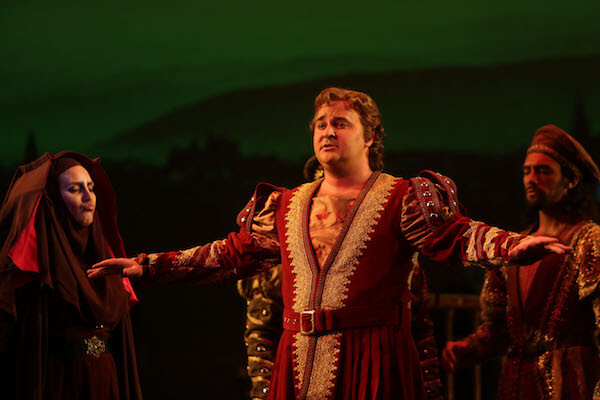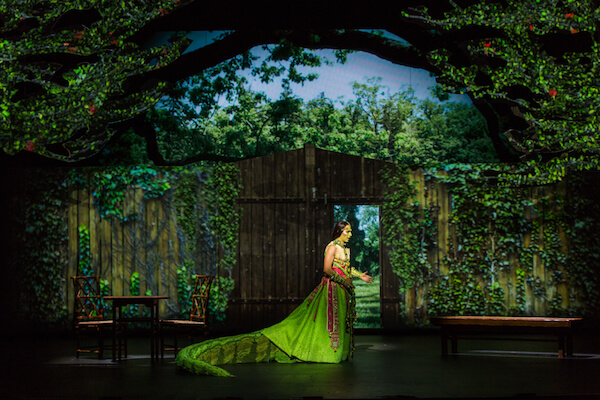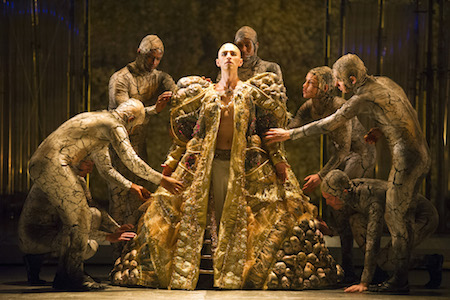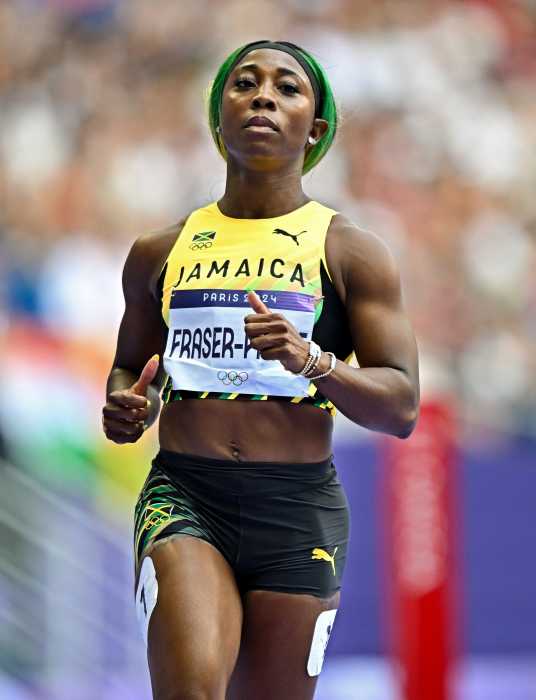Aaron Monaghan, Garrett Lombard, and Marty Rea in Samuel Beckett's Waiting for Godot, directed by Garry Hynes at Spoleto Festival USA. | MATTHEW THOMPSON
BY DAVID SHENGOLD| Alan Gilbert took his leave of the New York Philharmonic’s music directorship on June 6 with the third of three concert readings of “Das Rheingold.” It’s somewhat melancholy to contemplate the triumphant “Le Grand Macabre” with Doug Fitch that began his regime, foretelling a modernizing transformation in the Phil’s nature that never took place.
But this performance — unpretentiously and sensibly semi-staged by Louisa Muller — proved very exciting. Wagner’s 1869 “Ring” prologue is tough to stage well — consider the Met’s expensive, dangerous Robert Lepage fiasco for evidence. Gilbert’s forces gleamed, with only a few stray brass flubs; watching the strings in Wagner’s transitional passages was electrifying.
We heard three towering performances. Jamie Barton was a magnificent Fricka, her sumptuous voice as silky as her dress, fully attentive to details of language and movement. The superb singing actor Christopher Purves all but stole the show dramatically as Alberich, making every syllable, note, and glance count. Increasingly strong tenor Russell Thomas sounded wonderful as Loge and played the fire god with sly understatement. Eric Owens does not command a natural Wotan scope, but with his characteristic musical and verbal intelligence and very carefully applied dynamics he managed this installment quite well. Hard to imagine him getting through “Siegfried,” however.
Everybody in the cast was at least good, though Kelley O’Connor (Erda) and Christian Van Horn (Donner), both fine artists, seemed fundamentally vocally miscast here, and the usually stunning Tamara Mumford (Flosshilde) seemed somewhat off form. The refulgent bass Morris Robinson (Fasolt) contrasted with the rustier but more nuanced Stephen Milling (Fafner): an impressive giant pair. The other standouts were Brian Jagde, a strong, shining tenor as Froh (usually the “Rheingold” weak link, in my experience) and Jennifer Johnson Cano in clarion, terrific voice as Wellgunde.
Esa-Pekka Salonen — nearly sainted hereabouts for his excellent work at the Met in Janacek and Strauss and some great visiting gigs with the Los Angeles Philharmonic — may have lost critical ground here with his series of Mahler-themed Met Orchestra concerts at Carnegie. The June 3 matinée proved a disappointment, with a clean-toned but unexceptional reading of Schumann’s “Third” or “Rhenish Symphony” and a relatively opaque take on Mahler’s potentially sublime “Das Lied von der Erde.” The brass section — thrilling in the “First Symphony” three days before — went stray more than once. Magic largely absented itself.
The fine dramatic tenor Stuart Skelton struggled in the near-impossible writing, producing adequate volume but lifting into some high notes and nearly cracking others. Scottish mezzo Karen Cargill salvaged the afternoon, with her beautifully plush instrument and sensibility attuned to Mahler’s music. Salonen unpardonably frog-marched her through the middle section of “Von der Schoenheit,” but in the rapturous final “Der Abschied” allowed her the space and time to create a wistful mood and some gorgeously shaped phrases.
The highlights of Spoleto Festival USA’s busy opening weekend were two productions by Garry Hynes. Vivaldi’s often static operas get only rare American stagings. 1727’s “Farnace” (May 27), to Antonio Lucchini’s libretto, revisits some characters known from Mozart’s “Mitridate,” with Farnace inheriting Pontus’ throne and marrying Tamiri. Menaced by Pompey’s Roman armies and the implacable hatred of his mother-in-law Berenice, Farnace and his wife and son survive attacks and intrigue (Tamiri’s sister Selinda alternately seducing the Roman Aquilio and Gilade, her mother’s captain) before the inevitable “lieto fine” (sudden happy ending). The Spoleto audience — audibly not entirely comfortable with da capo arias, countertenors, or modern dress stagings — laughed some at the pythoness Berenice’s instant change of heart, but gave the production and performers a merited standing ovation.
Hynes’ admirably flowing staging centered on familial drama while implicitly reflecting on enduring Middle Eastern instability and insurgency against Western incursion. Francis O’Connor contributed an apt false perspective set with an entrancing, varied seascape background. Terese Wadden’s wonderful costumes contrasted shapely silhouetted but martial Pontian clothes with Roman business suits. James F. Ingalls lit superbly. In Act Two — judiciously edited — contemporary resonances grew stronger, with a photo of Aleppo’s ruins partially blocking the seascape.
David Peter Bates led swiftly; his harpsichord and the obbligato instruments were terrific, though the modern string players sometimes muddied Vivaldi’s textures. The enthusiastic, sonorous chorus sported over-American vowels. Anthony Roth Costanzo’s sophisticated musical and stage artistry and elegant dynamic control brought deserved success in the most heroic baroque challenge he has yet undertaken. Versatile Kiera Duffy tackled Berenice’s taxing music with spectacular ease and beauty, radiating banked venom. Rich contralto
Cassandra Zoe Velasco proved impressive vocally and dramatically, as did high-flying countertenor Nicholas Tamagna.
The two countertenors outshone their colleagues in providing meaningful recitative delivery. Naomi O’Connell (Selinda), beautiful and a fine actress, unfortunately showed a harsh, unlovely timbre. As her suitors, mezzo Augusta Caso (here playing a female warrior, so a lesbian wedding was part of the happy resolution) and Met baritone Kyle Pfortmiller sang very compellingly.
Both Hynes and Costanzo had fan bases from previous festival appearances. This summer, Hynes also showed a finely wrought “Waiting for Godot” with her troupe Druid Theater, and Costanzo took active part in the Dock Street chamber series — hosted by violinist Geoff Nuttall, genially channeling a Lyle Lovett vibe — offering arias from “Tito Manlio” and “Giustino” plus Ray Orbison’s “Crying.” The lamenting plea “Non ti lusinghe la crudeltade” from “Tito Manlio,” heard May 28, was an all-star affair, with sensational oboist James Austin Smith entwining his sound around Costanzo’s, plus informed support from cellist Christopher Costanza and harpsichordist Pedja Muzijevic.
“Waiting for Godot,” in the same intimate theater the same afternoon, found four character actors working off the same stylistic and linguistic page, a far cry from New York’s periodic Mike Nicholsy “all star” traversals of the play. Visually and in terms of action, this play stays remarkably unchanged, due to the exigent patrolling by Beckett’s estate, which will endure until 2059, the 70th anniversary of his death. What remains are questions of timing and shading.
Marty Rea (Vladimir) and Aaron Monaghan (Estragon) mined the lines’ humor; a sense of drama entered with Rory Nolan (an almost Wildean Pozzo) and Garrett Lombard (Lucky — in accordance with the text, a large figure instead of the sylph-like servant sometimes seen). The audience — initially restless — soon succumbed to the lilt-enhanced chamber music of Beckett’s existential riffing.
David Shengold (shengold@yahoo.com) writes about opera for many venues.



































